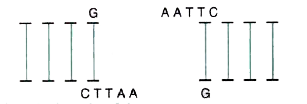An interesting property of restriction enzymes is molecular cutting and pasting. Restriction enzymes typically recognize a symmetrical sequence of DNA.

Notice that the top strand is the same as the bottom strand, but reads backward. When the enzyme cuts the strand between G and A, it leaves overhanging chains:

A. What is this symmetrical sequence of DNA known as?
B. What is the significance of these overhanging chains?
C. Name the restriction enzyme that cuts the strand between G and A.
A. Palindromic sequence
B. Sticky ends
C. EcoRI
Topper's Solved these Questions
- BIOTECHNOLOGY : PRINCIPLES AND PROCESSES BOOK - MODERN PUBLICATIONCHAPTER - BIOTECHNOLOGY : PRINCIPLES AND PROCESSES EXERCISE - Higher Order Thinking Skills & Brain Twisting ( Long Answer Questions )
4 Videos
- BIOTECHNOLOGY : PRINCIPLES AND PROCESSES BOOK - MODERN PUBLICATIONCHAPTER - BIOTECHNOLOGY : PRINCIPLES AND PROCESSES EXERCISE - Quick Memory Test ( A. Say True or False )
8 Videos
- BIOTECHNOLOGY : PRINCIPLES AND PROCESSES BOOK - MODERN PUBLICATIONCHAPTER - BIOTECHNOLOGY : PRINCIPLES AND PROCESSES EXERCISE - Higher Order Thinking Skills & Brain Twisting ( Very Short Answer Questions )
5 Videos
- BIOTECHNOLOGY AND ITS APPLICATIONSBOOK - MODERN PUBLICATIONCHAPTER - BIOTECHNOLOGY AND ITS APPLICATIONSEXERCISE - CHAPTER PRACTICE TEST (SECTION - E)
2 Videos
Similar Questions
An interesting property of restriction enzymes is molecular cutting. Restriction enzymes typically recognise a symmetrical sequence of DNA.

Notice that the top strand is the same as the bottom strand, but reads backward. When the enzyme cuts the strand between G and A, it leaves overhanging chains :

(a) What is this symmetrical sequence of DNA known as?
(b) What is the significance of these overhanging chains?
(c) Name the restriction enzyme that cuts the strand between G and A.
View SolutionA: Restriction enzymes belong to a larger class of enzymes called nucleases.
R: Each restriction enzymes recognises sequence in the DNA.
View Solution
Knowledge Check
DNA fragments cut by restriction enzyme can be separated by
APCRBELISACAgarose gel electrophoresisDDownstream processingA: Restriction enzymes belong to a larger class of enzymes called nucleases.
R: Each restriction enzymes recognises sequence in the DNA.AIf both Assertion & Reason are true and the reason is the correct explanation of the assertionBIf both Assertion & Reason are true but the reason is not the correct explanation of the assertionCIf Assertion is true statement but Reason is falseDIf both Assertion and Reason are false statementsRestriction endonuclease ( EcoRI) enzyme cut the strand of DNA
AFrom the centre of the palindromic sequence .Ba little away from the centre of the palindromic sequenceCa little away from recognization site.Dcuts only single-stranded DNA
A: Restriction enzymes belong to a larger class of enzymes called nucleases.
R: Each restriction enzymes recognises sequence in the DNA.
View SolutionRestriction endonuclease ( EcoRI) enzyme cut the strand of DNA
View SolutionAssertion : Restriction enzymes recongise palindromic sequences.
Reason : Palindromic sequences read same in both directions of the two strand.
View SolutionAssertion : Restriction enzymes recongise palindromic sequences.
Reason : Palindromic sequences read same in both directions of the two strand.
View SolutionThe restriction endonuclease enzyme binds to the DNA and cuts
View Solution
